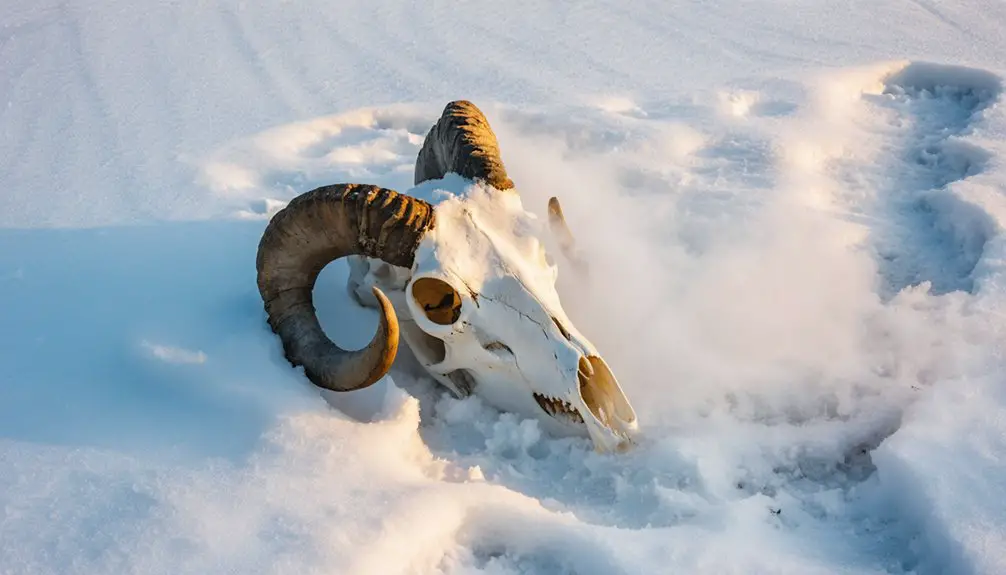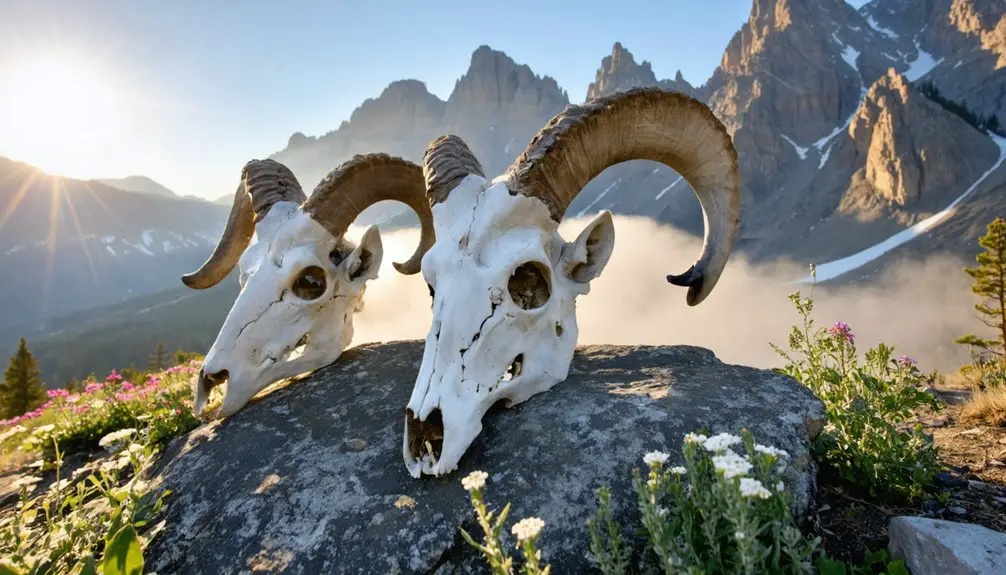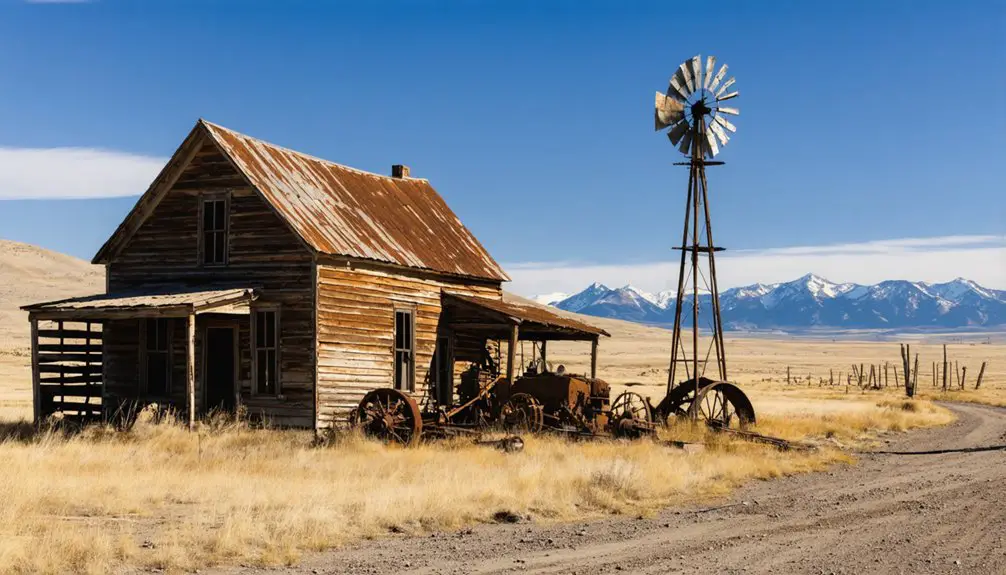You’ll find Wyoming’s bighorn sheep as living echoes of their once-vast populations, which declined from 100,000 to roughly 6,400 today. These hardy survivors navigate ancient migration routes across the state’s rugged terrain, from Dubois to Cody, where only 5% of historical numbers remain. While pneumonia outbreaks and habitat challenges threaten their existence, innovative DNA tracking and conservation efforts offer hope for these mountain monarchs, whose story continues to unfold across Wyoming’s wild landscapes.
Key Takeaways
- Wyoming’s bighorn sheep population has plummeted from over 100,000 to just 6,400, making these majestic animals increasingly rare sights.
- Ancient migration routes of bighorn sheep, now paralleled by modern highways, reveal ghostly paths of historical wildlife movement.
- The Whiskey Basin herd’s dramatic decline from 2,000 to under 500 sheep illustrates the vanishing presence of these mountain dwellers.
- Pneumonia outbreaks have devastated populations since the 1990s, leaving once-thriving herds as mere shadows of their former numbers.
- The Teton Range’s tiny native herd of 100-150 sheep represents the last remnants of historically abundant populations.
The Legacy of Wyoming’s Mountain Monarchs
While Wyoming’s Rocky Mountain Bighorn sheep once dominated the state’s rugged landscapes in numbers exceeding 100,000, today’s population of roughly 6,400 represents a stark decline that tells a sobering story of survival against mounting pressures.
From vast herds of 100,000 to mere thousands today, Wyoming’s bighorns fight a desperate battle for survival in their ancestral ranges.
You’ll find this bighorn heritage most dramatically illustrated in the core native herd stretching from Dubois to Cody. Once home to thousands, this population has dwindled to about 4,000 sheep – just 5% of what Lewis and Clark witnessed. The emergence of Mycoplasma ovipneumoniae bacteria has been identified as a primary threat to these majestic animals. Both male and female bighorns possess distinctive horns that set them apart from other mountain ungulates.
The iconic Whiskey Basin herd, which helped establish populations across the western U.S., has faced devastating conservation challenges, plummeting from 2,000 to fewer than 500 sheep.
While some reintroduced populations in areas like Devil’s Canyon show promising recovery, the species’ overall trajectory continues downward, shaped by disease outbreaks and habitat pressures.
Following Ancient Migration Paths
You’ll find Wyoming’s modern roads and highways trace ancient Native American trails that closely followed bighorn sheep migration corridors between seasonal ranges.
Today, tribal knowledge systems have gained renewed attention following the landmark Herrera v. Wyoming case.
The Mountain Shoshones developed ingenious sheep-trapping techniques along these pathways to sustain their communities.
These historic pathways, marked by stone cairns and utilized by tribes like the Crow and Mountain Shoshone, represent sophisticated knowledge of wildlife movement patterns that persisted for centuries.
While many of these traditional migration routes have been disrupted by human development, their legacy remains embedded in today’s transportation infrastructure and provides vital insights for contemporary wildlife conservation efforts.
Seasonal Movement Patterns Today
As winter’s harsh conditions approach, Wyoming’s bighorn sheep commence on their ancestral migration routes, moving between high-elevation summer ranges and lower winter habitats in a pattern passed down through generations.
You’ll find these animals following seasonal routes that their mothers taught them, descending thousands of feet to access vital forage and minerals in winter-friendly territories.
Their migratory behaviors are precisely timed with natural cycles, as they seek out south- and west-facing slopes where wind keeps the snow at bay.
They’ll navigate to specific destinations like Miller Butte on the National Elk Refuge, where natural salt licks provide essential minerals for their immune systems.
While some historic pathways remain intact, you’ll notice these magnificent creatures adapting their routes as human development increasingly fragments their traditional corridors.
Scientists are now using satellite tracking technology to better understand and protect these ancient migration patterns.
These social groups of bighorns stay together year-round, meeting other herds only during mating season.
Historic Routes Still Matter
Throughout millennia, Wyoming’s historic migration routes have served as essential pathways for both wildlife and indigenous peoples, creating an intricate network of corridors that remain relevant today.
You’ll find these ancient paths still guide modern travel, as highways like U.S. 14 and 14A follow routes once used by the Crow, while the Bannock Trail’s path through Yellowstone parallels current roadways near Electric Peak and Mammoth Hot Springs.
The cultural significance of these corridors extends beyond human use.
You’re witnessing living history when you observe bighorn sheep following the same paths their ancestors used thousands of years ago.
This route preservation isn’t just about maintaining wildlife movement – it’s about protecting a complex web of ecological and cultural connections that have shaped Wyoming’s landscape since prehistoric times.
Where Wild Sheep Still Roam
From low-elevation ranges in eastern Wyoming to the towering peaks of the western Rockies, bighorn sheep populations persist across the state’s diverse terrain.
From open prairies to soaring mountain peaks, Wyoming’s bighorn sheep thrive in the state’s rugged wilderness landscapes.
You’ll find these hardy survivors traversing rugged landscapes from 8,000 to 12,000 feet, particularly in strongholds like Whiskey Mountain and the Wind River Range. Their preferred bighorn habitats consistently feature escape terrain – steep cliffs and rocky slopes – interspersed with vegetation like limber pine, juniper, and mountain mahogany. Research shows that distance to escape terrain is one of the most crucial factors in determining where these sheep choose to live.
Across Wyoming’s approximately 15 distinct populations, sheep interactions vary from small, isolated groups of 25 to robust herds exceeding 1,000 individuals. After facing significant population declines in the early 1900s, restoration efforts have helped maintain these herds across the state.
The Teton Range hosts Wyoming’s smallest native herd, with 100-150 sheep maintaining a tenuous existence in increasingly fragmented habitat, while the Whiskey Mountain population remains one of the state’s largest.
Survival Against Modern Threats
You’ll find Wyoming’s bighorn sheep populations traversing a complex web of survival challenges, with pneumonia outbreaks serving as their primary threat and contributing to a decline from 7,000 animals in the early 1990s.
The harsh mountain terrain that provides refuge also presents survival difficulties, particularly when herds approach carrying capacity as seen in the Jackson population of nearly 500 sheep. The densest populations continue to thrive in northwestern Wyoming near Yellowstone, where the rugged landscape offers natural protection.
While some herds maintain stability or show slight increases, you’re witnessing an ongoing battle between these resilient animals and modern pressures, including disease transmission, habitat limitations, and environmental stressors that complicate their recovery.
Disease and Population Decline
While Wyoming’s bighorn sheep have faced numerous challenges throughout their history, disease outbreaks remain the most devastating threat to their survival.
You’ll find the disease impact most severe in the state’s largest native herds, where pneumonia-related pathogens drastically limit lamb survival and trigger population-wide die-offs. The genetic consequences of these crashes have left lasting scars, with population bottlenecks reducing diversity essential for disease resistance. Modern management efforts include limiting harvest and preventing outbreaks.
- Pneumonia outbreaks cause “all-ages” mortality, decimating both adults and juveniles
- Historical populations plummeted to just 2,000 sheep by the 1960s
- Domestic sheep contact introduces deadly pathogens to wild herds
- Population genetics show concerning loss of diversity despite translocation efforts
Today’s conservation efforts focus on pathogen identification and maintaining genetic diversity to protect these iconic animals against future disease outbreaks.
Harsh Environments Shape Survival
Despite their remarkable adaptations, Wyoming’s bighorn sheep now face unprecedented survival challenges in their harsh mountain environments.
You’ll find these creatures battling extreme conditions where energy conservation becomes critical for survival. Deep snow, bitter cold, and limited vegetation force them to carefully manage their resources through winter months.
Modern threats compound these natural challenges. When you venture into their territory during winter recreation, you’re triggering flight responses that drain their precious energy reserves.
The consequences are severe – especially for vulnerable 8-month-old lambs and pregnant ewes. Climate shifts further complicate survival, altering snow patterns and forage availability.
Habitat fragmentation constrains their natural migration strategies, while competition from non-native mountain goats and domestic sheep strains their already limited resources in these harsh climates.
DNA Tracking: A New Era of Research

Since the introduction of non-invasive DNA monitoring techniques in 2019, researchers have revolutionized how they track and study Wyoming’s bighorn sheep populations.
Through genetic monitoring of fecal samples, scientists now identify individual sheep and assess population dynamics with unprecedented accuracy, revealing numbers closer to 175 sheep rather than the previously estimated 100.
This breakthrough in conservation strategies has uncovered distinct genetic clusters across Wyoming’s mountain ranges:
- Five primary populations inhabit the Absaroka, Devil’s Canyon, Jackson, Kouba Canyon, and Whiskey Mountain regions
- DNA analysis tracks successful breeding between translocated sheep
- Gene flow patterns reveal connectivity between specific herds
- Genomic tools evaluate the effectiveness of translocation efforts
You’ll find these insights are reshaping how we comprehend and protect these magnificent creatures in Wyoming’s rugged terrain.
The Future of Wyoming’s Living Legends
As Wyoming’s bighorn sheep populations show signs of recovery, their future hinges on a complex interplay of habitat management, disease prevention, and conservation strategies.
You’ll find future conservation efforts focusing on maintaining herds above 300 sheep while expanding sustainable habitats through invasive plant control and prescribed burns.
The Jackson herd’s situation, hovering at carrying capacity with 500 sheep, exemplifies the delicate balance managers must strike.
Modern DNA sampling techniques are revolutionizing population monitoring, helping you track genetic health with unprecedented accuracy.
While pneumonia remains a persistent threat, collaborative research between agencies offers promising solutions.
The path forward demands adaptive management across Wyoming’s varied terrain, from Yellowstone’s rugged wilderness to south-central’s moderate landscapes, ensuring these magnificent creatures thrive for generations to come.
Frequently Asked Questions
How Long Do Bighorn Sheep Typically Live in the Wild?
You’ll find that Bighorn lifespan in wild habitat typically ranges from 10-20 years, though this varies by subspecies, with females often living longer than males under natural conditions.
What Is the Average Weight Difference Between Male and Female Bighorns?
Did you know male bighorns can carry up to 14kg of horn mass alone? You’ll find males typically outweigh females by 50-100%, with Rocky Mountain rams weighing 175-300 lbs versus ewes at 125-200 lbs.
Can Bighorn Sheep Interbreed With Domestic Sheep?
While bighorn genetics allow interbreeding with domestic sheep, you’ll find it’s not recommended due to reduced hybrid vigor and serious disease risks that can devastate wild populations through transmission.
How Fast Can Bighorn Sheep Run When Fleeing From Predators?
You’ll find bighorn sheep can sprint up to 20 mph during predator evasion, utilizing their specialized speed adaptations like muscular legs and grip-enhanced hooves to navigate rugged terrain while escaping danger.
What Natural Predators Pose the Greatest Threat to Wyoming’s Bighorns?
Where there’s smoke, there’s fire – and in Wyoming’s rugged terrain, mountain lions pose your bighorns’ greatest predatory threat, while wolf packs and other predators have relatively minimal impact.
References
- https://www.wyomingwildsheep.org/wp-content/uploads/2022/02/BighornSheepConsiderationsProjects.pdf
- https://www.nps.gov/grte/learn/news/dna-study-provides-new-information-on-teton-bighorn-numbers.htm
- https://www.huntinfool.com/states/wyoming/bighorn-sheep
- https://wafwa.org/wp-content/uploads/2024/07/2024-Rangewide-Status-of-Wild-Sheep_07082024.pdf
- https://www.tetonscience.org/the-big-horns-of-bighorn-sheep/
- https://www.wyomingwildsheep.org/wp-content/uploads/2024/06/2022-WAFWA-BHS-Report-for-Wyoming.pdf
- https://wyomingwildlife.org/the-state-of-wyomings-wild-sheep-with-steve-kilpatrick/
- https://jacksonholehistory.org/learn/archives-research/master-engineers-a-shoshone-sheep-trap-by-ron-mamot/
- https://www.wyohistory.org/encyclopedia/wyoming-american-indian-geography-and-trails
- https://www.jhecotouradventures.com/insights/page/wyomings-mammal-migrations-break-long-distance-records



